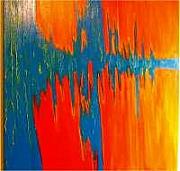 Bright with a gusty, chilly wind this Tuesday afternoon on California’s north coast — nice to finally see some sunshine after a seemingly unending fog-overcast weather mood for weeks.
Bright with a gusty, chilly wind this Tuesday afternoon on California’s north coast — nice to finally see some sunshine after a seemingly unending fog-overcast weather mood for weeks.
Supposed to be like this for awhile.
And supposedly, we’ve got a little “earthquake swarm” apparently happening off the coast of Oregon (probably about 250-300 miles northwest of my location) with another two fairly-sized rockers last night, making a total of seven shakers in less than 24-hours, ‘but they are not a signal that a bigger quake is about to happen.’
(Illustration: ‘Earthquake,’ by Jakara Art, found here).
Although three were 5.0-or-better, the geology is complicated — via KOIN 6 News in Portland:
“These earthquakes are happening in a totally different part of the system and aren’t really relevant in a physical way,” USGS seismologist Seth Moran said.
According to Moran, Monday’s quakes are on a fault line farther out to sea than the much more dangerous fault line right off the Oregon coast.
That closer fault line — the Cascadia-Subduction Zone — has caused huge quakes in the past and is currently building up pressure.
“The area where it’s stuck is roughly like this and if that entire patch were to go all at once, that’s the magnitude 9,” Moran said.
“It’s a long fault, it’s a wide fault.”
Scientists at the U.S. Geological Survey said it usually takes an earthquake of magnitude 7 or better to trigger a tsunami.
However, all this shit is just really highly-scientific conjecture.
From USAToday and Robert Dziak, a research oceanographer with the National Oceanic and Atmospheric Administration based in Newport, Ore:
In Oregon, the series of quakes took place on the west side of the Juan de Fuca Plate.
The Cascadia subduction zone, which threatens a megaquake here, is on the east side of the plate.
“It’s not clear that they’re linked seismologically,” Dziak said.
“The link as a precursor event is not clear.”
And add a little of this — from the Seattle Times:
A 2008 agency report said the zone had produced about 70 quakes of magnitude 5.0 or greater in the previous 28 years.
In 2008, scientists detected a swarm of hundreds of smaller quakes.
Scientists say Monday’s quakes are so far away there’s little chance they could raise the risk of a quake on the Cascadia Subduction Zone, the dangerous fault much closer to shore that has generated megaquakes and tsunamis in the past.
“It’s not zero, but it’s almost vanishingly small,” said John Vidale, director of the Pacific Northwest Seismic Network at the University of Washington.
Vidale said it’s also unlikely — though not impSossible — that the quakes are linked to a recent eruption of Axial Seamount, an underwater volcano about 90 miles from the epicenters.
My underline for emphasis on earth-movement paranoia, and ground-floating anxiety…